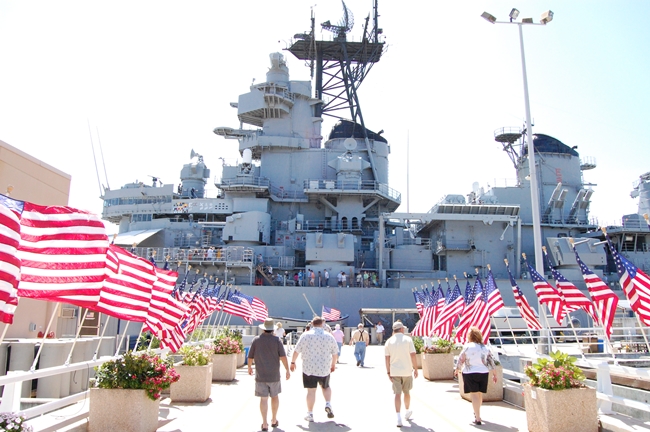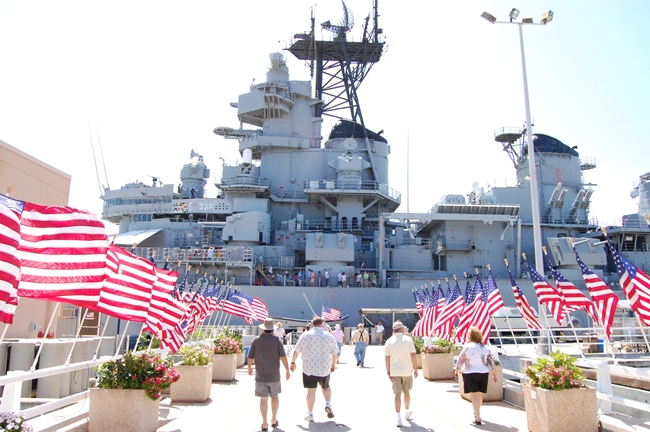Article and photos:Quoc Vinh
Painful memories
As the 50th state admitted to the United States on August 21, 1959 and located in the middle of the Pacific Ocean, the Hawaiian Islands are a long chain of islands with a total area of nearly 17,000 km² and a population of more than 1.5 million. The largest is the Hawaiian Island (over 10,000 km²) located at the extreme end of the archipelago, but the most important is the Oahu Island with an area of about 1500 km², located about 140 miles northwest of Hawaii. On the south coast of Oahu Island is the city of Honolulu with more than 350 thousand people, the capital of the entire archipelago with more than 55% of people of Asian descent.
Also on the island's south coast, about six miles west of Honolulu, is Pearl Harbor, the main base of the US Pacific Fleet since 1940. Built on a bay that cuts deep into the island's mainland and divides it into many hidden seas and channels, there is an island in the middle of the bay called "Ford Island". This is like a natural pier, making Pearl Harbor an ideal natural condition to protect the fleet against any outside attack. The harbor's defenses are extremely careful with a special steel net system against torpedoes and submarines. In addition to Pearl Harbor, the fleet has another base, the port of Lahaina on the island of Maui, an island located about halfway between Oahu and Hawaii.

According to historical documents, on the morning of December 7, 1941, a group of Japanese fighter planes suddenly bombed American warships in Pearl Harbor, causing a terrible shock. Because Japan had not issued an official declaration of war before suddenly attacking Pearl Harbor, while the two countries, the United States and Japan, were still in the negotiation stage.
As soon as he ordered the end of the battle of Pearl Harbor, Japanese Admiral Yamamoto, the Japanese naval commander of this attack, sensed the difficulties that Japan would face. And indeed, this victory was an important turning point in World War II, leading to President Roosevelt reading the United States' Declaration of War against Japan at 12:30 on December 8.
Foreign military circles believe that the attack on Pearl Harbor is a lesson in being careless and unprepared for war. In terms of intelligence, Japan had been preparing for the attack for years, and prepared for combat in all aspects for more than 11 months to successfully carry out a battle of great strategic significance in nearly three hours. Pearl Harbor is also the title of a film directed by Michael Bay, produced in 2001 about the attack in 1941. The film is more of a love story than an accurate chronicle of the event, although some of the events presented actually happened. Some of the ship scenes in the film were filmed on the USS Lexington in Corpus Christi, Texas. At the 2001 Academy Awards, the film was nominated in four categories and won the category of “Best Sound Editing”.
When the green fills
74 years after that terrible moment, Pearl Harbor is still operating normally. Warships and aircraft carriers still enter and leave the port and have been recognized as a historical site since January 29, 1964. And the flow of people from everywhere still flocks here to visit every day. Although they are not allowed to enter the working area of the aircraft carriers, visiting the warships and visiting the memorial also helps them understand more about the history of this land...
Among the attractions here, the first one that cannot be missed is the USS Arizona Memorial. The destruction of the USS Arizona and the great loss of naval forces involved in the sinking was the reason the United States entered World War II. Today, the USS Arizona Memorial is operated by the National Park Service and attracts many visitors.
The memorial is free to enter, but visitors must have a ticket to enter. Tickets are distributed free of charge from 7am and the program is open to visitors from 7:45am to 3:00pm every day. A maximum of just over 2,000 tickets are issued each day.
The USS Arizona Memorial tour lasts about 75 minutes, including watching a 23-minute documentary with English subtitles depicting the battle on a giant screen that is assembled from three sides if time permits. Then visitors take a boat to visit the memorial, see the list of US Navy soldiers who died with the ship to the bottom of the bay during the attack engraved on a giant marble tablet, and take pictures of the rusty gun turret of the sunken aircraft carrier that is still above the water. If visitors watch long enough, they can still see drops of oil leaking from the ship and bubbling up to the surface. The tour guide further explained that for more than half a century, sailors at Pearl Harbor have held flag-raising and flag-lowering ceremonies every day on the USS Arizona Memorial, because they believe that there are thousands of soldiers inside the wreck and the ship is still operating as it was assigned.
Visitors can also continue to visit the USS Bowfin Submarine Museum & Park. The submarine, named “Pearl Harbor Avenger,” was launched on December 7, 1942, and sank 44 enemy ships during its nine war patrols. Visitors can also spend more than an hour touring other submarines in Bowfin Park and the Waterfront Memorial, which commemorates the 52 U.S. submarines and more than 3,500 Allied submarines lost during World War II.

To see how a massive aircraft carrier operates, visitors should board the Missouri. Weighing more than 58,000 tons and lying 900 feet below the surface, the battleship USS Missouri was recommissioned on January 29, 1944, and continued to participate in operations during the final months of World War II. Visitors need at least 2 hours to explore all the nooks and crannies of the ship like a miniature military city, touch the giant guns, see the daily activities of the US Navy as well as look out over a corner of Hawaii.
The last stop is the Pacific Aviation Museum, opened in 1999, also located on Ford Island and is a must-see attraction, especially for those who are passionate about the wingspan of the iron birds. This is also the place to display enough models of Japanese warships and aircraft, 1,764-pound bombs, nearly 7-meter-long aerial torpedoes, or the operations of the radio, code transmissions for the attack, and many other valuable documents.

If you’re not scared of weapons or death, take a walk along the riverbank where a memorial walkway has been set up with facts, photos and diagrams of the Pearl Harbor attacks. It’s a gentle alternative and there’s no admission fee!
Today, the Hawaiian Islands have become a famous tourist destination, attracting visitors from all over the world. They come here not only for sightseeing but also to learn more about the great event in American history. The road leading to Pearl Harbor, seen on Google Earth satellite map, seems difficult to find, but in fact, it is just a straight road like the horizon, mixed with the blue of the ocean, the blue of the clouds, and the rows of coconut trees, helping visitors feel the peaceful blue color returning to spread throughout every corner of this place...
MORE INFORMATION:
- A “No Bag” policy applies to Pearl Harbor. Due to enhanced security measures, no purses, handbags, backpacks, fanny packs, camera bags, diaper bags, luggage, or any other type of bag that can conceal items are allowed inside Pearl Harbor, the Information Center. Only cameras and camcorders are allowed, all other bags must be checked in at the depository at the entrance to the national park for a fee of $3.
- The USS Arizona Memorial is always crowded, especially in the summer, when the weather is good and on weekends. Therefore, visitors should come early to get free tickets at the Pearl Harbor visitor center.
- Official information on visiting Pearl Harbor can be found at: www.pearlharborhistoricsites.org
- The city bus route to Pearl Harbor is numbered 20 and 42, and the fare is $2.50 per trip.
- On the way, you can stop at the bus stop to visit Chinatown with many local products as well as Vietnamese stalls.
- Hawaiian cuisine is rich and diverse but also quite expensive. Visitors should try Hawaiian Pizza and Hawaiian Sandwich, both of which have pineapple as the main ingredient.






.JPG_2.JPG)

.JPG_5.JPG)



























